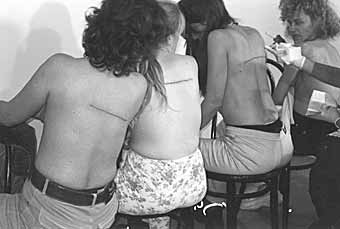Santiago Sierra: Radical Cruelty and Second Reflection
BY Thom Donovan
I spent the good part of the day yesterday brainstorming for two classes I will teach in the spring, the first on ecology and aesthetic practices, the second—tentatively—on the withdrawal (or occultation) of the image in modern and contemporary poetry and art.
For the latter syllabus—intended for art students at School of Visual Arts in NYC—I was thinking about a trajectory of texts that would start in Alain Resnais’ Hiroshima, Mon Amour (in which repeats the phrase “You have seen nothing”), and end with art practices after Adorno’s concept of “second reflection” (Paul Chan's for one).
Though his practice does not have to do with “withdrawal” per se, someone who came to my attention researching for the class is the Spanish artist Santiago Sierra, whose incredible website documenting twenty years of work can be viewed here: http://www.santiago-sierra.com/index_1024.php. The trajectory of the work is startling in the ways that it posits art through sites of social antagonism and the global expropriation of living labor.
Sierra’s work begins with Richard Serra-esque sculpture: large sculptural works moved from industrial sites into exhibition spaces. The plot thickens as Sierra transitions from removing industrial sculptural materials from sites of human endeavor to paying human beings to perform menial tasks, often for wages that the workers might earn for a task they would normally perform (prostitution, heavy lifting, standing or sitting in place for lengths of time, etc.).
The poems that I write (and much poetry that I find attractive) is nourished by a devotion to intermedia, and a desire to understand images by using the poem as a means of processing. In general, I am interested in these uses of the poem: the poem as intuitive plastic, as pedagogical tool, as preposterously critical, as (presencing of) second reflection. Perhaps, as Charles Bernstein suggests in his collaboration with Richard Tuttle Reading Red, one can write a poem that acts not merely ekphrastically (outside or about the image), but that somehow speaks with or from the position of the art work.* What, a la Wittgenstein, would the image say if it could speak?
So often that is what art begs of us, breaking the spell of our contemplative engagement with world making. The images that most haunt me after viewing all of Sierra’s documented works online represent prostitutes who have been paid with heroin to allow their backs to be tattooed with a continuous horizontal line:
http://www.santiago-sierra.com/200014_1024.php
My visceral reaction to seeing the documentation of this performance was nausea, outrage, and sadness. Yet, although Sierra’s art is an art of cruelty, it will never match the cruelty of the social relations which we participate in at every moment of our lives—those, I would argue, Sierra wishes to remind us of by dramatizing their logics. Wanting to speak with those images I wrote the following…
If they are not paid
To eat any fucking
Thing they want to eat
Whenever they want to
And not abide
By their insanest purchases
On wanting to be
On wanting
To be in the world
The scar that could be made on their backs
Will be made on their backs
Because we can
The scar that is some one’s power
To pay them and never
A living wage is a striking thing
Living in this discrepancy
The risk of losing you in me
Becomes something to sing.
*see Bernstein's interview with Mei-mei Bersenbrugge for an extensive description of the collaboration.
Thom Donovan lives in New York City where he edits Wild Horses of Fire weblog (whof.blogspot.com) and...
Read Full Biography


